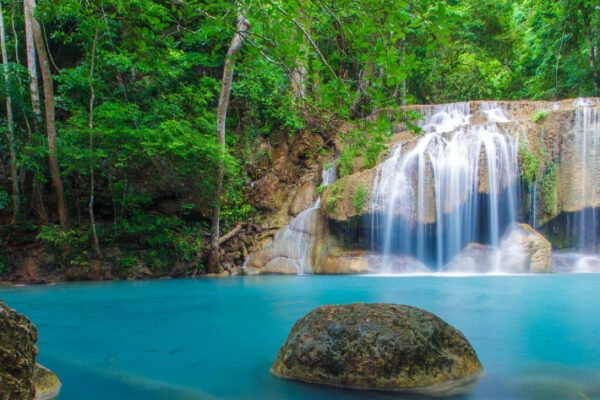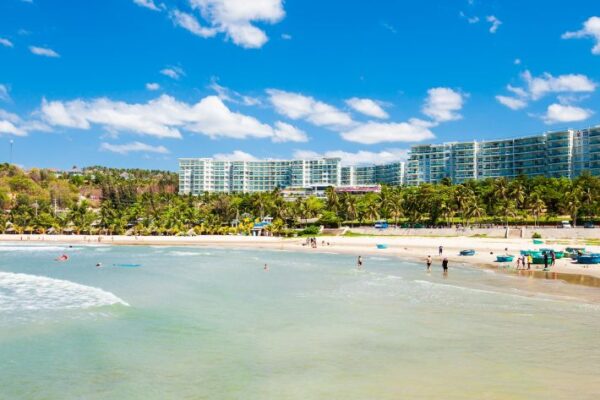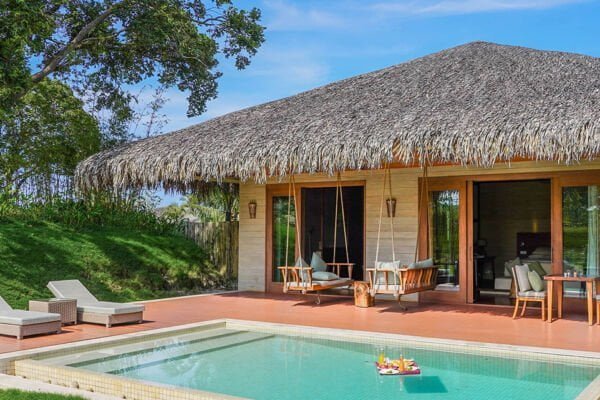What to Do in Thailand for 2 Weeks: A Guide for Every Type of Traveler

Thailand is a traveler’s paradise, offering endless adventures and cultural treasures. Planning what to do in Thailand for 2 weeks can feel overwhelming with so much to explore, but don’t worry—this guide will help you make the most of your journey. Let’s map out the perfect 14-day itinerary to uncover the best this incredible country offers!
Top Unique Experiences That You Cannot Miss During 2 Weeks in Thailand
For Adventure Lovers
In two weeks, you can challenge your limits, connect with nature, and immerse yourself in heart-racing activities that will make your trip unforgettable. Here’s a list of the most unique and adventurous experiences to include in your Thailand itinerary.
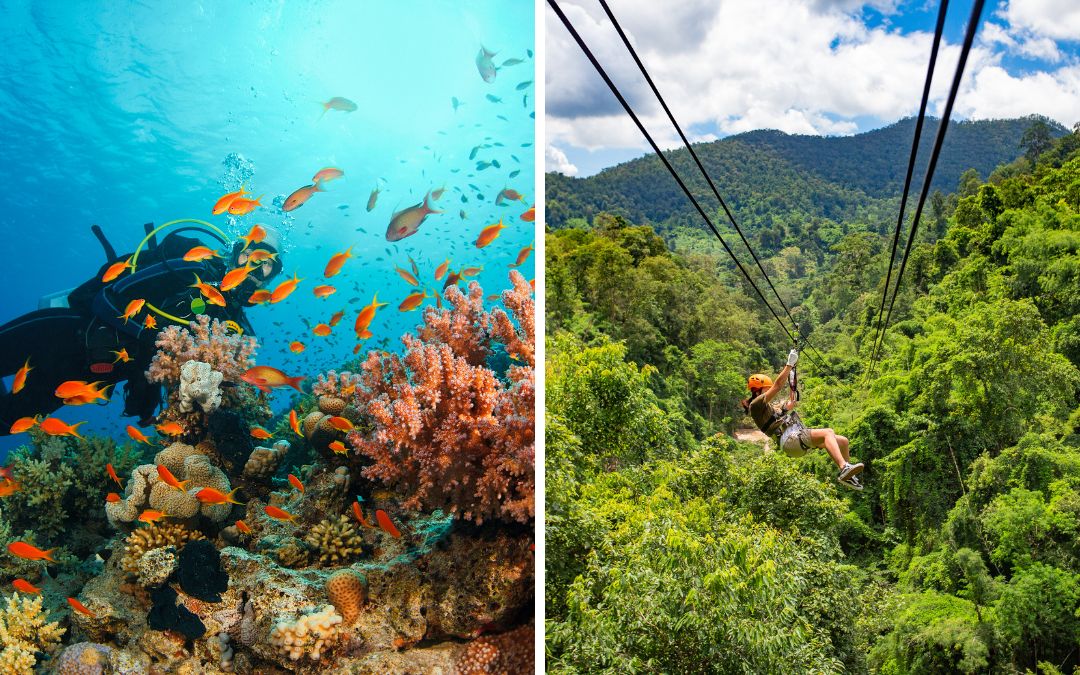
Thailand’s varied landscapes offer a multitude of adventure experiences, from diving to zip-lining.
- Rock Climbing in Railay Beach: Iconic limestone cliffs provide an exciting challenge for climbers of all levels. Professional guides and safety gear ensure a safe and memorable experience. Half-day climbing packages cost $30–$60, combining breathtaking views with a rewarding sense of achievement.
- Kayaking Through Phang Nga Bay: Exploring Phang Nga Bay by kayak reveals dramatic limestone cliffs, hidden caves, and serene lagoons. Guided tours cost $35–$70 per person, making it an affordable and eco-friendly way to immerse yourself in Thailand’s coastal beauty. A calm yet exhilarating adventure awaits paddlers of all levels.
- Jungle Trekking in Khao Sok National Park: Towering trees, cascading waterfalls, and unique wildlife define this trek through Thailand’s oldest rainforest. Guided treks, priced at $40–$95, often include a boat ride on Cheow Lan Lake, creating an unforgettable nature escape.
- Scuba Diving in the Similan Islands: A vibrant underwater world featuring coral reefs and diverse marine species awaits divers. Full-day diving tours cost $115–$170, covering equipment and guides. Known as a top diving spot, this activity is perfect for marine enthusiasts.
- Ziplining in Chiang Mai: Thrilling rides through lush treetops reveal panoramic views of northern Thailand, a must for anyone exploring what to do in Thailand for 2 weeks. Tour packages, ranging from $50–$100, include multiple ziplines, suspension bridges, and abseiling for an adrenaline-filled adventure.
- Hot Air Balloon Rides in Chiang Mai: Drift above the stunning countryside of Chiang Mai at sunrise with a hot air balloon ride. The tranquil experience costs $225–$285 per person and often includes breakfast. This activity is ideal for travelers wanting a serene yet adventurous finale to their trip.
- Cliff Jumping at Tonsai Beach, Krabi: Tonsai Beach lures thrill-seekers with its cliff-jumping spots, featuring breathtaking ocean views. The jumps vary in height, catering to both beginners and experienced adventurers. Safety measures are essential, and guided sessions cost $45–$60. The turquoise waters below make every leap worthwhile.
- White Water Rafting in Chiang Mai: Rapid-filled Mae Taeng River offers an adrenaline-packed experience surrounded by lush jungle scenery. Guided tours, suitable for beginners and experts, cost $50–$85. A thrilling escape into the heart of northern Thailand.
- ATV Riding in Pattaya: Navigate rugged trails, mud tracks, and scenic hills on an ATV in Pattaya. This thrilling ride costs $70–$120, covering safety gear and guides. Ideal for adventurers looking to venture off the beaten path while soaking up stunning views of the countryside.
>> See Tour: Essential Thailand Tour Package
For Cultural Enthusiasts
Thailand’s rich culture unfolds through vibrant traditions, ancient temples, and unique local practices. For travelers who crave more than just sightseeing, the country offers immersive experiences that connect you with its heritage. Here are some of the most memorable cultural activities to add to your two-week journey in Thailand.

Buddhism has profoundly shaped Thai culture.
- Attend the Yi Peng Lantern Festival in Chiang Mai: The magic of thousands of lanterns floating into the sky is a breathtaking sight during Yi Peng. Held annually in November, this festival celebrates new beginnings. Admission costs vary depending on the event, ranging from $10–$30 for public areas to $100–$300 for private zones.
- Explore the Ancient City of Ayutthaya: Wandering through the ruins of Ayutthaya feels like stepping back in time. Once a thriving Siamese capital, this UNESCO World Heritage Site showcases temples, stupas, and statues of immense historical value. Entry fees to major sites cost $2–$6 per person, with guided tours available for deeper insights.
- Join a Thai Cooking Class in Bangkok: Learning to cook authentic Thai dishes is both educational and delicious. Classes include visits to bustling markets to source ingredients before hands-on lessons. Expect to pay $25–$50 for a half-day experience, with the bonus of enjoying your creations afterward.
- Discover Traditional Lanna Culture in Chiang Mai: The Lanna heritage of northern Thailand comes to life through art, music, and dance. Cultural centers offer performances and workshops, costing $15–$30. Don’t miss the opportunity to learn how to carve wood or craft traditional umbrellas.
- Witness Almsgiving in Luang Prabang: Observing monks receiving alms at sunrise is a humbling cultural ritual. This spiritual practice, deeply rooted in Buddhist tradition, takes place daily across Thailand. While free to watch, contributing to the ceremony with offerings costs $5–$10 for prepared food sets.
- Explore the Grand Palace in Bangkok: The glittering spires and intricate details of the Grand Palace reflect Thailand’s royal history, making it a highlight among the best activities for two weeks in Thailand. The centerpiece, Wat Phra Kaew, houses the sacred Emerald Buddha. Entrance fees are $15 per person, and guided tours are available for an additional cost.
- Visit Local Hill Tribes in Northern Thailand: Connecting with hill tribes such as the Karen or Hmong offers a glimpse into Thailand’s ethnic diversity. Tours, priced at $40–$80, often include visits to villages, traditional weaving demonstrations, and opportunities to support local artisans by purchasing handmade crafts.
- Experience a Khon Masked Dance Performance: Khon, a traditional Thai masked dance, tells epic stories through intricate movements and stunning costumes. Performances, held at cultural theaters, cost $20–$50, depending on the venue. It’s a captivating way to appreciate Thailand’s classical arts.
- Take a Boat Tour of the Amphawa Floating Market: The charm of Thailand’s floating markets lies in the colorful boats and bustling traders. Amphawa offers an authentic experience, especially in the evenings. Boat tours cost $5–$15 per person and provide a chance to savor local delicacies while soaking up the lively atmosphere.
>> See tour: Thailand Beach Tour and Temples Exploration
For Beach Seekers
Thailand’s islands and beaches are the stuff of dreams, boasting white sands, turquoise waters, and swaying palm trees. Perfect for sunbathers, snorkelers, and anyone craving a tropical escape, these coastal gems promise serenity and adventure. If you’re wondering what to do in Thailand for 2 weeks, these breathtaking beaches deserve a spot on your itinerary.
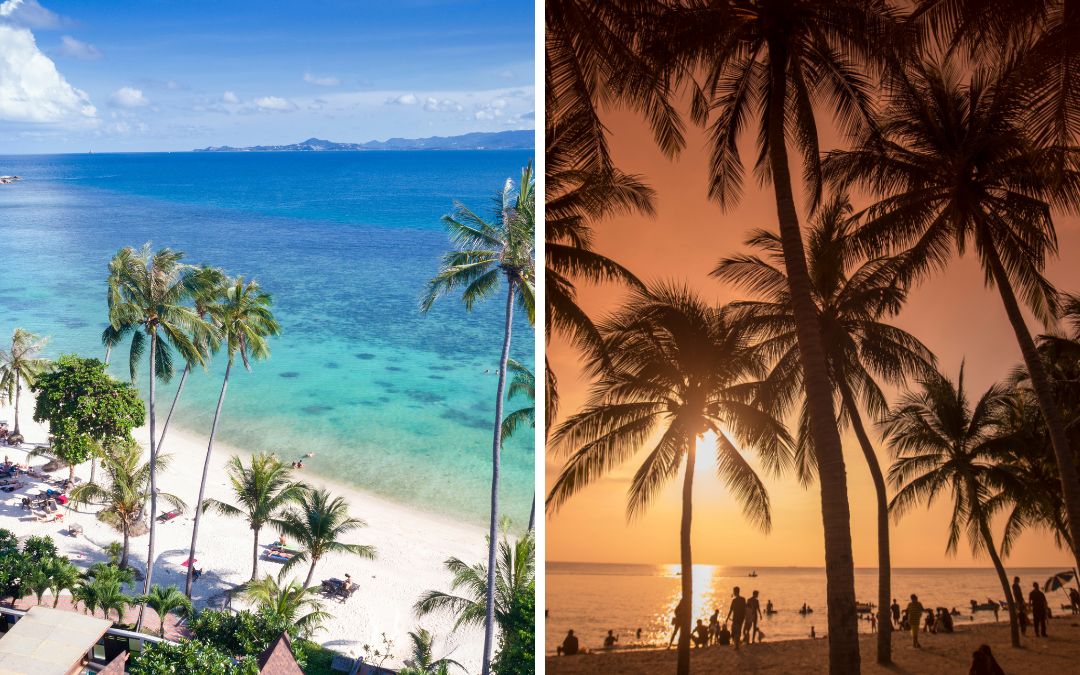
From Phuket to Koh Phi Phi, Thailand’s diverse beaches offer something for every traveler.
- Railay Beach, Krabi: Limestone cliffs and lush greenery surround a hidden paradise accessible only by boat, Railay Beach. Perfect for rock climbing or simply relaxing on pristine sands. Longtail boat transfers cost around $5–$10, while nearby eateries keep you fueled for exploration.
- Phra Nang Cave Beach, Krabi: Tucked away near Railay, this beach combines stunning beauty with cultural significance. The cave shrine dedicated to the spirit of the sea draws visitors, and the waters are ideal for kayaking. Entry is free, and kayak rentals cost around $10–$20.
- Patong Beach, Phuket: Vibrant nightlife, bustling markets, and water sports make Patong a lively destination. Jet ski rentals cost $30–$50 per hour, while beachfront lounges and restaurants add to the experience. Perfect for those looking for energy-packed days and nights.
- White Sand Beach, Koh Chang: The powdery sands and clear waters of White Sand Beach are perfect for unwinding. This family-friendly spot is lined with casual beach bars and accommodations. No entry fee applies, though nearby massages start at $10 for a truly relaxing day.
- Koh Nang Yuan, Surat Thani: This tiny island, close to Koh Tao, captivates visitors with its iconic sandbar connecting three islets. Snorkeling reveals vibrant marine life, with day trips costing $20–$40, including boat transfers and equipment. A serene spot for unforgettable photos.
- Maya Bay, Koh Phi Phi Leh: Highlighted as one of the top places to visit in Thailand in 14 days, Maya Bay stuns with emerald waters and dramatic cliffs. Known from The Beach movie, the site enforces sustainability rules after reopening, allowing limited visitors. Entry fees are $12 for foreigners.
- Ao Nang Beach, Krabi: A gateway to nearby islands, Ao Nang Beach, combines convenience with scenic beauty. Beachfront strolls, sunset views, and affordable boat rides make it an ideal base. Longtail boats to nearby spots cost $5–$10, perfect for spontaneous adventures.
- Karon Beach, Phuket: The expansive Karon Beach charms visitors with its quiet atmosphere and soft sands. Perfect for families or those seeking a laid-back vibe, it’s free to enjoy, with nearby food stalls offering local dishes starting at $3.
- Lamai Beach, Koh Samui: Lamai Beach blends beauty with cultural attractions like the Grandfather and Grandmother Rocks. Water activities, beachfront spas, and fresh seafood abound. Kayak rentals cost around $10, while dining by the water is surprisingly affordable.
Thailand’s beaches promise more than just relaxation—they deliver unforgettable experiences and memories to last a lifetime. Which one will you explore first?
>> Read More: Guide To An Unforgettable 10-Day Beach Vacation In Thailand
For Foodies
Thailand’s food scene celebrates bold flavors, fragrant spices, and visually stunning dishes that delight the senses. This is more evident than in Bangkok, a city renowned as a street food haven. Bustling markets overflow with iconic dishes that showcase the essence of Thai cuisine. For food lovers wondering how to indulge during their two-week trip, these must-try experiences are not to be missed.
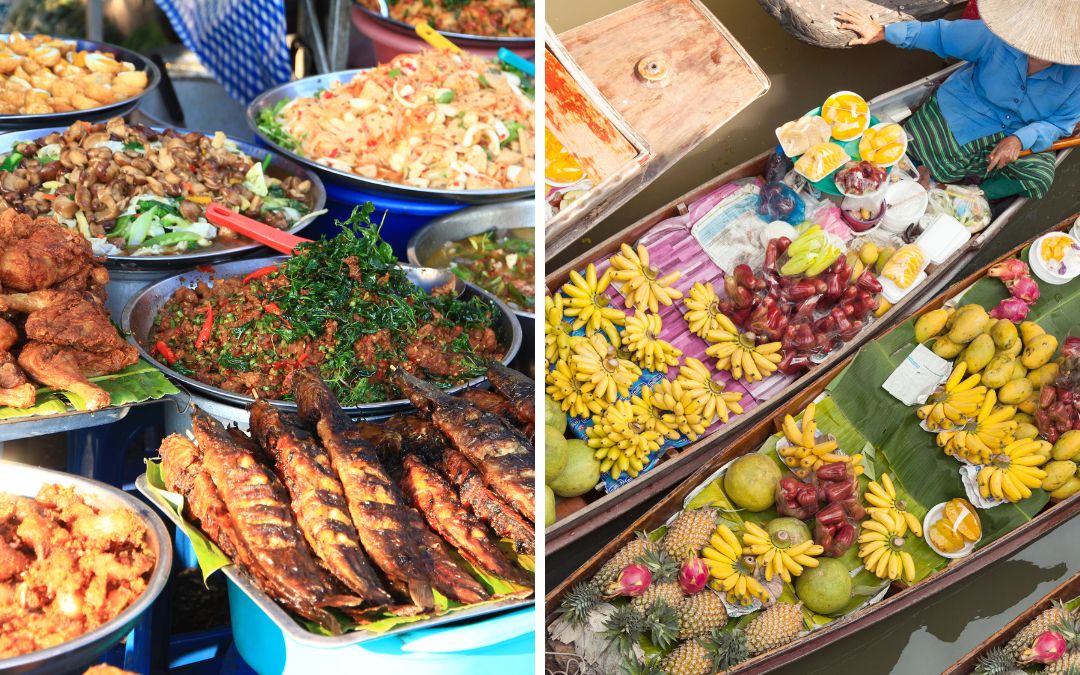
Local food stalls offer a wide variety of options, from savory dishes to fresh fruits.
- Dive Into the Rich Flavors of Tom Yum Goong: Aromatic and spicy, tom yum goong is best enjoyed at P’Aor in Bangkok, renowned for its creamy version of the classic soup. Packed with fresh shrimp and tangy lime, a bowl costs $2–$5, making it a flavorful introduction to Thai cuisine.
- Savor the Sweet Simplicity of Mango Sticky Rice: At Mae Varee in Bangkok, mango sticky rice is a dessert delight, pairing ripe mangoes with coconut-infused sticky rice. A portion costs $1–$3, offering a perfect balance of sweetness and texture to end your meal.
- Explore Bangkok’s Chinatown for Pad Thai: Head to Thip Samai, often dubbed the “Pad Thai King,” to taste this iconic noodle dish cooked over charcoal for an irresistible smoky flavor. Prices range from $1.50–$3, and the bustling Chinatown ambiance enhances every bite.
- Delight in the Crunch of Som Tum in Isan: For the freshest green papaya salad, visit Somtum Der in Khon Kaen, where the spicy, tangy, and slightly sweet som tum is a crowd favorite. A plate costs $1–$2, making it a must-try in the Northeast.
- Sip Authentic Thai Iced Tea in a Local Market: For anyone following a perfect two-week plan for Thailand, the Chatuchak Weekend Market in Bangkok is a great place to enjoy Thai iced tea. Brewed with strong black tea and sweetened with condensed milk, it costs $0.50–$1, offering a refreshing pause from exploring.
- Feast on Freshly Grilled Satay Skewers: Taling Chan Floating Market in Bangkok serves some of the best satay skewers, marinated to perfection and grilled over charcoal. At $0.50–$1 per skewer, the rich peanut sauce complements the smoky flavor beautifully.
- Indulge in the Spice of Green Curry in Chiang Mai: The Herb Garden Restaurant in Chiang Mai is known for its creamy and aromatic green curry. Served with jasmine rice, a meal costs $2–$6, making it a comforting dish full of fresh, local ingredients.
- Discover the Bold Taste of Massaman Curry in Phuket: At Raya Restaurant in Phuket, massaman curry is prepared with tender beef and rich spices, embodying the fusion of Indian and Thai flavors. A serving costs $3–$6, offering a hearty and flavorful experience.
- Wander Through Night Markets for Khanom Buang: The Ratchada Night Market in Bangkok is the go-to spot for khanom buang, crispy Thai crepes filled with either sweet coconut cream or savory options. These bite-sized treats cost around $0.50 each, and watching the vendors make them is part of the charm.
>> Read More: Thai Food Guide – 9 Dishes You Should Know And Try
How To Plan Your 2-week Trip: Mixing Themes or Sticking to One?
When Deeply Diving Into One Theme
Focusing on a single theme offers a chance to fully immerse yourself in Thailand’s essence while keeping the pace relaxed. If you’re deciding what to do in Thailand for 2 weeks, this tailored approach lets you uncover the country’s charm in a more meaningful way.
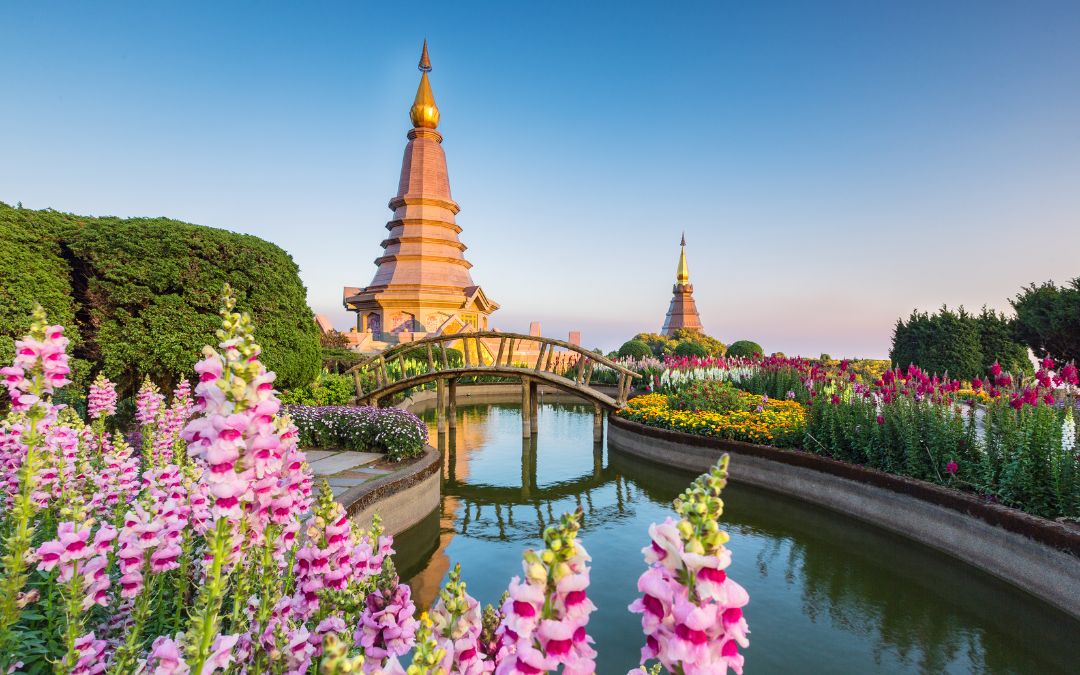
By choosing a theme, you can fully focus on each aspect of its richness in Thailand.
- Adventure and nature: Northern Thailand’s lush jungles and mountainous terrain set the stage for trekking through Mae Hong Son and ziplining in Chiang Mai. Encounters with ethical elephant sanctuaries add a memorable touch of wildlife interaction.
- Cultural exploration: The ancient ruins of Ayutthaya and Sukhothai highlight Thailand’s storied past. Traditional experiences like alms-giving in Chiang Mai or exploring ornate temples in Bangkok provide deeper cultural insights.
- Beach bliss: Thailand’s southern islands, like Koh Samui and Koh Lanta, offer pristine beaches perfect for lounging. Sunset boat rides and snorkeling adventures showcase the crystal-clear waters of the Andaman Sea.
- Culinary adventures: Bangkok’s street food markets and Chiang Mai’s cooking classes immerse travelers in the flavors of Thailand. A trip to floating markets like Amphawa adds a unique twist to the food journey.
When Combining The Travel Styles
Blending different travel styles creates a well-rounded Thai experience, showcasing its vibrant contrasts and diverse attractions. This approach keeps the journey dynamic, appealing to varying tastes within any travel group.
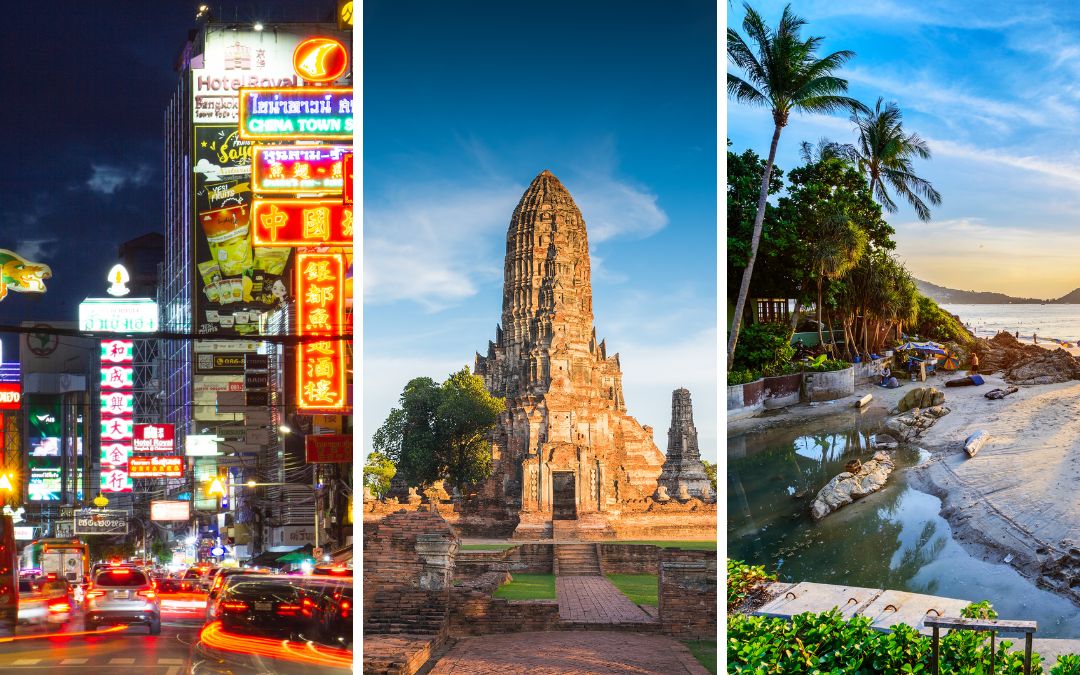
Combining all three types of tourism in one trip will enrich the itinerary and emotions.
- Start with Urban & Food Exploration: Bangkok sets the stage with bustling street markets, iconic dishes like pad thai and mango sticky rice, and vibrant nightlife. Chinatown and Chatuchak Market are must-visits for an authentic food adventure.
- Add Cultural Highlights: Ancient ruins in Ayutthaya and serene temples in Chiang Mai provide a deeper connection to Thailand’s history and spirituality. Don’t miss the chance to witness traditional ceremonies or local festivals.
- End with Beaches and Seafood: Finish the trip on the islands of Krabi or Phuket, relaxing by turquoise waters and savoring freshly caught seafood. A longtail boat ride to hidden coves adds a perfect touch of adventure.
>> Read More: 10 Days in Thailand – 3 Ultimate Family-Friendly Itineraries
How to Decide the Best for You
Planning a two-week trip to Thailand involves several key considerations to ensure a fulfilling and enjoyable experience. Factors such as travel time, prioritized experiences, travel companions, and seasonality play crucial roles in shaping your itinerary. Let’s delve into each aspect to help you decide whether to mix themes or focus on a single experience during your stay.
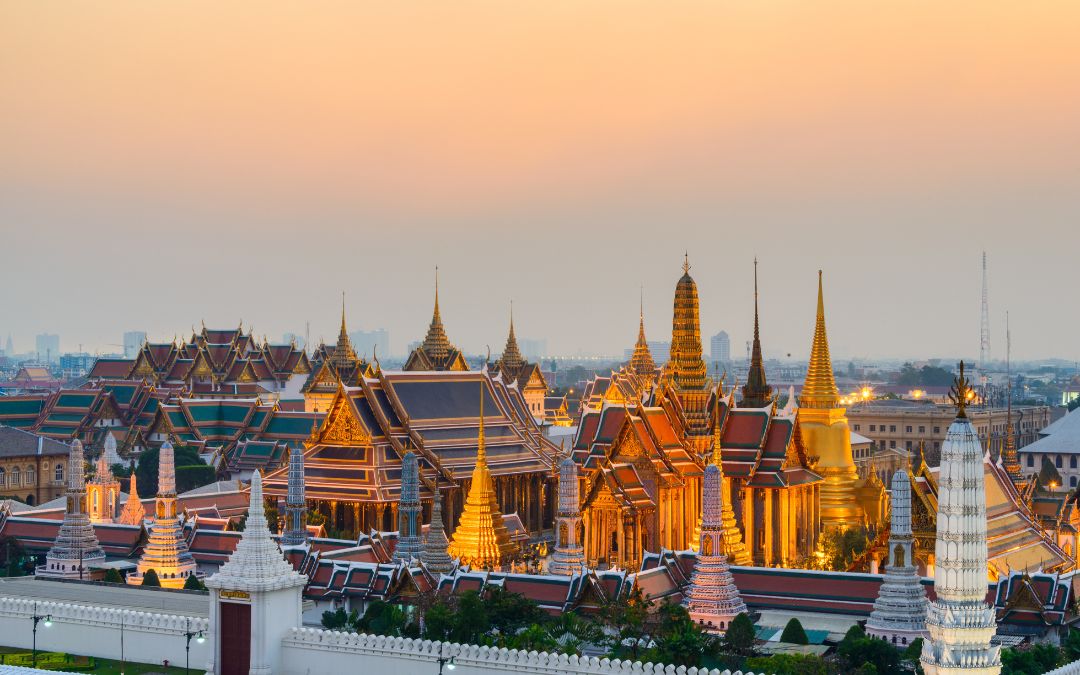
Traveling to Thailand at different times offers seasonal experiences, like festivals and local cuisine.
Travel Time
Thailand offers a diverse range of destinations, from bustling cities like Bangkok to serene islands such as Koh Samui and cultural hubs like Chiang Mai. Efficiently managing travel time between these locations is essential to maximize your two-week itinerary.
Domestic flights are the quickest option, with airlines like Thai Airways and AirAsia offering routes between major cities and tourist spots. For instance, a flight from Bangkok to Chiang Mai takes approximately 1 hour and 15 minutes, while Bangkok to Phuket is about 1 hour and 25 minutes.
Alternatively, Thailand’s extensive bus and train networks provide cost-effective travel, though journeys can be lengthy; for example, an overnight train from Bangkok to Chiang Mai can take around 12 to 15 hours.
Prioritize Experiences
Identifying your primary interests is vital. Are you drawn to cultural landmarks, beach relaxation, adventure activities, or culinary explorations? Thailand’s regions cater to various preferences:
- Cultural enthusiasts: Northern Thailand, particularly Chiang Mai and Chiang Rai, is rich in temples, traditional arts, and local markets.
- Beach lovers: Southern Thailand boasts idyllic beaches and islands. The Andaman Sea side, including Phuket and Krabi, is renowned for clear waters and limestone cliffs, while the Gulf of Thailand side, featuring Koh Samui and Koh Phangan, offers vibrant nightlife and tranquil retreats.
- Adventure seekers: National parks like Khao Sok provide trekking, wildlife spotting, and kayaking opportunities.
- Food aficionados: Bangkok is a haven for street food, while each region offers unique culinary delights.
Travel Companions
Your travel companions’ preferences and needs significantly influence your itinerary. Families might prioritize destinations with child-friendly activities and accommodations, such as Phuket, known for its family resorts and safe beaches.
Groups of friends might seek vibrant nightlife or adventure activities, making places like Bangkok or Koh Phangan suitable choices. Couples may prefer romantic getaways, with islands like Koh Yao Noi offering secluded beaches and luxury resorts.
Seasonality
Thailand’s climate varies across regions and seasons, affecting travel plans:
- Cool season (November to February): This is the peak tourist season, with pleasant temperatures nationwide. It’s an ideal time for beach destinations and outdoor activities.
- Hot season (March to May): Temperatures soar, especially in inland areas. Coastal regions remain more comfortable, making beach destinations preferable.
- Rainy season (June to October): Characterized by heavy rainfall, particularly in September and October. Some islands, especially on the Andaman coast, may experience rough seas, affecting boat services. However, the Gulf of Thailand islands like Koh Samui are less affected and can be visited during this period. Additionally, the rainy season often means fewer tourists and lower prices.
>> Read More: Best Time To Visit Thailand
Start Planning: What to Do in Thailand for 2 Weeks Right Now!
Thailand is a treasure trove of experiences, offering something unique at every turn. If you’re still wondering what to do in Thailand for 2 weeks, this guide provides the perfect starting point to plan your adventure. From cultural landmarks and vibrant cities to idyllic beaches and mouthwatering cuisine, your journey will be unforgettable.
Ready to make it happen? Contact Asia Trip Deals for expert advice and tailored itineraries that bring your Thai adventure to life with ease and style!
